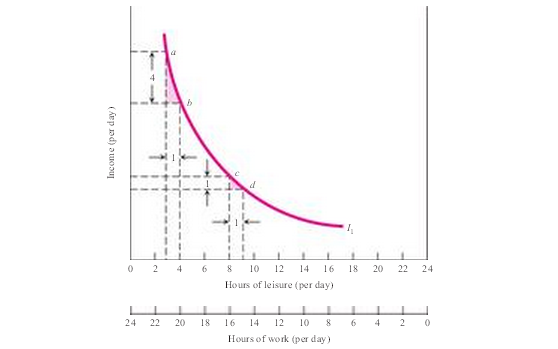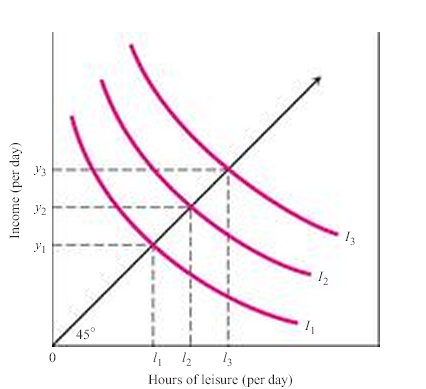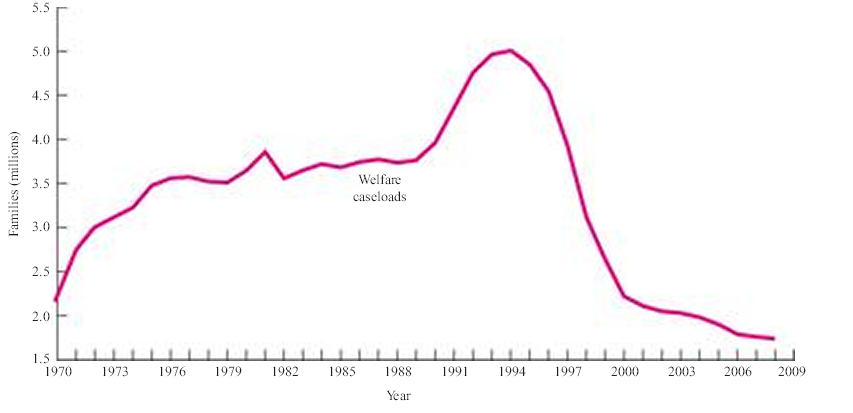In this chapter Campbell McConnell, Stanley Brue and David Macpherson discuss the peculiarities of individual labor supply and focus on the decisions that people can take regarding their employment. They pay more attention to such factors as income and leisure time that influence worker’s attitudes toward their jobs. This information can be of great use to people who study economics because they have to understand the factors influencing labor relations.
One of the tools that are described by the scholars is the income-leisure indifference curve. This curve is supposed to demonstrate the level of satisfaction or utility yielded by various combinations leisure and income (Picture 1).

This chart describes different combinations of leisure time and income per day. So, utility or satisfaction can be viewed as a dependent variable, while daily income and leisure time are independent ones. The authors also discuss such a tool as the indifference map that describes different levels of utility (Picture 2).

This chart describes various levels of utility that are produced by different combination of leisure and income. This map can be viewed as a set of indifference curves that illustrate the preferences of a person.
Overall, these concepts are extremely important for employers who have to find ways of retaining workers. They have to determine what kind of compensation packages will best satisfy the needs of employees. They have to find the most optimal ratio of leisure and compensation in order to retain workers. This is why the knowledge of such tools is important for economists and business administrators.
Secondly, the authors pay special attention to the individual preferences of people when they choose their employers. They may have different expectations for income and leisure. For instance, some individual can be called workaholics who may be ready to sacrifice a part of leisure time in order to earn a larger amount of income. In contrast, their people are more concerned with their leisure and their work-life balance.
Thus, one can say that the behavior of individuals can differ significantly. This behavior can depend on such factors as age, gender, family status, or education level of an employee. So, companies should look at the demographic characteristics of workers. Additionally, Campbell McConnell, Stanley Brue and David Macpherson point out that a person’s attitude toward income and leisure can be affected by budgetary constraints. For instance, people can be more sensitive to the changes in wage rate, if employment is the only source of income for him/her. In contrast, this person may be less concerned with leisure time.
Again, employers should understand their needs of their workers and factors that shape their decisions. The task of companies is to achieve the highest attainable indifference curves while keeping budget costs to the minimum. In other words, they should retain the most talented workers and improve their financial performance. However, they cannot cope with this task if they do not understand the preferences of workers.
In this chapter, the authors explain how a person’s attitude toward income and leisure can change. In particular they describe the so-called substitution effect. Overall, it means that a person’s attitude toward leisure may be affected the increase or decrease in the wage rate. For instance, the increase in wage may raise the cost of leisure, as a result an individual may be more willing to sacrifice a part of his/her leisure time in order to earn more. Such an individual will be ready to work more. The scholars regard leisure as a good that may have different prices that are strongly affected by the wage rate. The knowledge of substitution effect can of great help to modern companies who want to find ways of motivating their workers and making them more committed to organizational goals.
This chapter also includes a discussion of empirical evidence regarding the individual preferences of workers. In particular, the authors point out that people may respond differently to the changes in wage rates or leisure time. For example, the scholars point out that women are usually more responsive to the changes in the wage rate, in comparison with men. The authors believe that males are less likely to do housework; thus, for them leisure is associated with relaxation.
This is why they attach more importance to leisure time. Yet, one should note that married women are less sensitive to the increase in salary. In contrast, young males may attach more importance to the level of compensation. In my opinion, it is a very important observation because economists and business administrators should understand what kind of things employee value most of all.
Another concept that I found interesting is the reservation wage. Overall, this concept denotes the lowest amount of compensation that can make a person willing to work. The reservation wage depends on a variety of factors such as leisure time, the prestige of work, and career prospects. Additionally, reservation point can refer to the amount of compensation when a person believes that the compensation is not worth their effort. In other words, this is a situation when the value of work and the value of leisure are equal.
Under such circumstance, an employee is very likely to terminate his/her employment and seek a different job. In my view, this concept should of great relevance to modern companies that try to reduce their labor costs. This notion of the reservation wage should be considered by policy-makers who attempt to set the minimum wages that companies are obliged to pay their employees.
Apart from that, this chapter discusses such concepts as underemployment and over employment. The researchers explain the circumstances when a person may feel underemployed or over-employed. According to the findings discussed in this chapter, low-wage earners and young workers are more likely to work more hours. Yet, there are several circumstances when a person can feel over-employed, for instance, his/her sacrifice of leisure time is not reflected in the wage rate.
This person may eventually lose ones motivation. Similarly, an individual can feel underemployed when excessive amount of leisure time prevents him/her from earning extra income. Thus, HR policies of l companies cannot disregard the behavior of workers who can have different values, attitudes, and priorities. The scholars also note that over-employment may result in high turnover rate and absenteeism. So, managers should be aware of these risks. They should know when and why an individual can feel either over-employed or underemployed.
Furthermore, this chapter is important because it describes various income maintenance programs existing in contemporary American society. They can be also called as public assistance programs that are supposed to help people who face severe economic difficulties due to some reasons. The knowledge of this issue can be of great importance to economists who work with public administrators. The authors describe three characteristics of this assistance that the government offers, namely:
- the minimum amount of income guaranteed to a person;
- the reduction of benefits provided that the income of a family grows;
- break-even point which means that the person’s expenses correspond to the benefits that he/she receives from the state.
These are the traits that should be taken into consideration. The availability of public assistance affects a person’s attitude toward employment, especially such aspects as leisure time, daily income, or willingness to work overtime.
Additionally, according to the scholars, the importance of public assistance has dramatically declined within the last two decades. This decline can be attributed to several important factors. Since 1994 the number of welfare assistance declined, because unemployment decreased in the United States (Picture 3).

In other words, the necessity for public assistance decreased. Secondly, tax subside enabled many families to increase their prosperity. These governmental initiatives increased the prosperity of American people.
Overall, this information should be taken into account by policy-makers who want to alleviate the economic difficulties faced by many American workers nowadays. By discussing these concepts, the authors highlighted the issues that contemporary government should remember.
The concepts and ideas discussed in this chapter are relevant to policy-makers, employers, economists, or HR managers. The knowledge of workers’ behavior and their preferences is important because it can help many companies to improve their policies. Overall, the individual preferences can greatly affect the labor relations in a society. Furthermore, the knowledge of public assistance programs is important for policy-makers or employers.